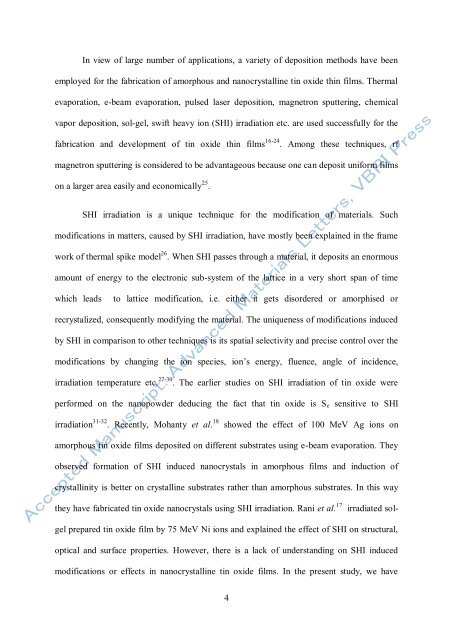Modification of nanocrystalline rf sputtered tin oxide thin film using ...
Modification of nanocrystalline rf sputtered tin oxide thin film using ...
Modification of nanocrystalline rf sputtered tin oxide thin film using ...
You also want an ePaper? Increase the reach of your titles
YUMPU automatically turns print PDFs into web optimized ePapers that Google loves.
In view <strong>of</strong> large number <strong>of</strong> applications, a variety <strong>of</strong> deposition methods have been<br />
employed for the fabrication <strong>of</strong> amorphous and <strong>nanocrystalline</strong> <strong>tin</strong> <strong>oxide</strong> <strong>thin</strong> <strong>film</strong>s. Thermal<br />
evaporation, e-beam evaporation, pulsed laser deposition, magnetron sputtering, chemical<br />
vapor deposition, sol-gel, swift heavy ion (SHI) irradiation etc. are used successfully for the<br />
fabrication and development <strong>of</strong> <strong>tin</strong> <strong>oxide</strong> <strong>thin</strong> <strong>film</strong>s 16-24 . Among these techniques, <strong>rf</strong><br />
magnetron sputtering is considered to be advantageous because one can deposit uniform <strong>film</strong>s<br />
on a larger area easily and economically 25 .<br />
SHI irradiation is a unique technique for the modification <strong>of</strong> materials. Such<br />
modifications in matters, caused by SHI irradiation, have mostly been explained in the frame<br />
work <strong>of</strong> thermal spike model 26 . When SHI passes through a material, it deposits an enormous<br />
amount <strong>of</strong> energy to the electronic sub-system <strong>of</strong> the lattice in a very short span <strong>of</strong> time<br />
which leads to lattice modification, i.e. either it gets disordered or amorphised or<br />
recrystalized, consequently modifying the material. The uniqueness <strong>of</strong> modifications induced<br />
by SHI in comparison to other techniques is its spatial selectivity and precise control over the<br />
modifications by changing the ion species, ion’s energy, fluence, angle <strong>of</strong> incidence,<br />
irradiation temperature etc. 27-30 . The earlier studies on SHI irradiation <strong>of</strong> <strong>tin</strong> <strong>oxide</strong> were<br />
pe<strong>rf</strong>ormed on the nanopowder deducing the fact that <strong>tin</strong> <strong>oxide</strong> is Se sensitive to SHI<br />
irradiation 31-32 . Recently, Mohanty et al. 18 showed the effect <strong>of</strong> 100 MeV Ag ions on<br />
amorphous <strong>tin</strong> <strong>oxide</strong> <strong>film</strong>s deposited on different substrates <strong>using</strong> e-beam evaporation. They<br />
observed formation <strong>of</strong> SHI induced nanocrystals in amorphous <strong>film</strong>s and induction <strong>of</strong><br />
crystallinity is better on crystalline substrates rather than amorphous substrates. In this way<br />
they have fabricated <strong>tin</strong> <strong>oxide</strong> nanocrystals <strong>using</strong> SHI irradiation. Rani et al. 17 irradiated sol-<br />
gel prepared <strong>tin</strong> <strong>oxide</strong> <strong>film</strong> by 75 MeV Ni ions and explained the effect <strong>of</strong> SHI on structural,<br />
optical and su<strong>rf</strong>ace properties. However, there is a lack <strong>of</strong> understanding on SHI induced<br />
modifications or effects in <strong>nanocrystalline</strong> <strong>tin</strong> <strong>oxide</strong> <strong>film</strong>s. In the present study, we have<br />
4
















